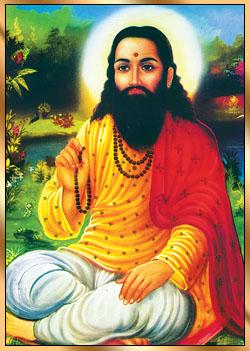 Born in Mandur near Kashi, bhakta–poet Raidas was the son of a cobbler. It is a general consensus that he was born in Samvat 1433 (1377 CE), on Magh sud 15 (Purnima). Since the day was a Sunday, he was named Ravidas, which later became Raidas in Hindi and Rohidas in Gujarati.
Born in Mandur near Kashi, bhakta–poet Raidas was the son of a cobbler. It is a general consensus that he was born in Samvat 1433 (1377 CE), on Magh sud 15 (Purnima). Since the day was a Sunday, he was named Ravidas, which later became Raidas in Hindi and Rohidas in Gujarati.
It is said that during his previous birth Raidas was a Brahmin pandit, the disciple of Swami Ramanand. The disciple begged alms from which he cooked for the guru. Swami had instructed him not to beg alms from an unscrupulous man in town. Once during the monsoon, the disciple had no choice but to obtain alms from this man. After having the food cooked from these alms, the guru lay down for his usual nap. But he could not sleep; his mind in turmoil. Swami then questioned the disciple, who admitted to begging alms from the evil man. For this error, he had to take another birth. In this birth Swami Ramanand was still alive. Later, once again, Raidas adopted him as his guru. Along with Kabir and ten others, Raidas was among the twelve senior disciples of Ramanand.
From birth he enjoyed the company of sadhus which angered his father. Once in a fit of anger he kicked Raidas out of the house.
Raidas built a hut outside the town, spending his time in singing bhajans and sewing shoes. He possessed a beautiful murti with four arms – the chaturbhuj form of Paramatma. Everyday he sang devotional bhajans in front of this murti such as,
‘Prabhuji tum chandan ham pãni,
jãki angang bãt samãni....’
i.e. “O Prabhu, You are the sandalwood paste and I am mere water, your fragrance is pervading this chandan.”
Unable to tolerate Raidas’s worship of the murti, a jealous Brahmin once complained to the local king, that this practice would wreak havoc in the kingdom. The king summoned Raidas with the murti. In the palace, Raidas listened to the complaint and then placed the murti on a bajoth. He then challenged the Brahmins:
‘O Brahmins! You are the beloved bhaktas of Bhagwan. Chant your mantras so that the murti jumps onto your lap.’ The Brahmins began their recitation but the murti did not budge an inch. Then Raidas began to sing:
‘Narhari chanchal hai mati meri, kaise bhakti karu me teri?’
i.e. “O Hari, my intellect is unstable, with what shall I offer you devotion?”
When the bhajan ended the murti literally flew into Raidas’s lap! Shamed, the Brahmins scrambled out. The king then honoured Raidas.
On one occasion a thirsty merchant passing by asked Raidas for some water. Raidas poured some into his cupped palms from a leather container. Water in a leather container is considered impure. Therefore, instead of drinking it, the merchant let it drip down his elbows onto his upper garment, causing a stain. The next morning when his washerwoman noticed the stain, she chewed the patch in the hope of dissolving it. By the intake of even a minuscule remnant of Raidas’s water, the woman attained trikal jnan – the power of knowing the past, present and future! Later a friend of the merchant paying him a visit, questioned her whether her master was at home. She replied, ‘No, he has gone to the leather market.’ In reality the merchant was indoors performing puja. Hearing the woman’s apparently false reply he stormed out.
‘Why did you lie? You knew I was inside.’
‘Master, though you were inside, physically doing puja, your mind was at the leather market!’
The merchant was astonished and inquired how she had attained such power. She recounted the previous day’s chewing of the stained patch. The merchant then realised his error and Raidas’s exalted status and returned to venerate him.
Once, a sadhu pained on seeing Raidas’s poverty, gave him a parasmani. In his presence the sadhu took the cobbler’s needle and touched the gem. The iron needle turned into gold. Raidas was not the least bit enticed and replied, “I do not want this maya.” But the sadhu placed the parasmani on a shelf in the house and left. Thirteen months later he returned. Raidas told him, Collect it from where you left it. I have not touched it. Thus he remained detached from worldly enticements.
Once Queen Zali Ratnakunvarba, wife of Maharana Kumbh of Chitor visited Kashi on a pilgrimage. Along with the Brahmins, she invited Raidas to have a meal. The Brahmins refused to sit with him. Therefore, he sat separately. When everyone started eating, to their horror, they saw one Raidas sitting between every two Brahmins! When the Brahmins stood up, they saw only Brahmins. As they sat down to eat, they again saw images of Raidas sitting between them! The Brahmins then realised that whatever varna a bhakta is, he may still have attained an exalted status. The rani then accepted Raidas as guru. Another Rajput queen, Mirabai, also became his disciple (see Ch. 32). Describing himself, Raidas said,
Jãtibhi ochhi, karambhi ochhã, ochhã kisab hamãrã,
niche se Prabhu unch kiyo hai, kahã Raidas chamãrã.
i.e. ‘My varna is low, my deeds are low, my talent is low, yet Prabhu has uplifted me from such a lowly state.’
Raidas lived till the age of 120 (105 according to another source) and died in 1519 in Chitor. Here, in the compound of Mirabai’s Krishna mandir where he was cremated, there is a shrine named Sant Raidaski Chhatri. Today his following is known as Raidasi..